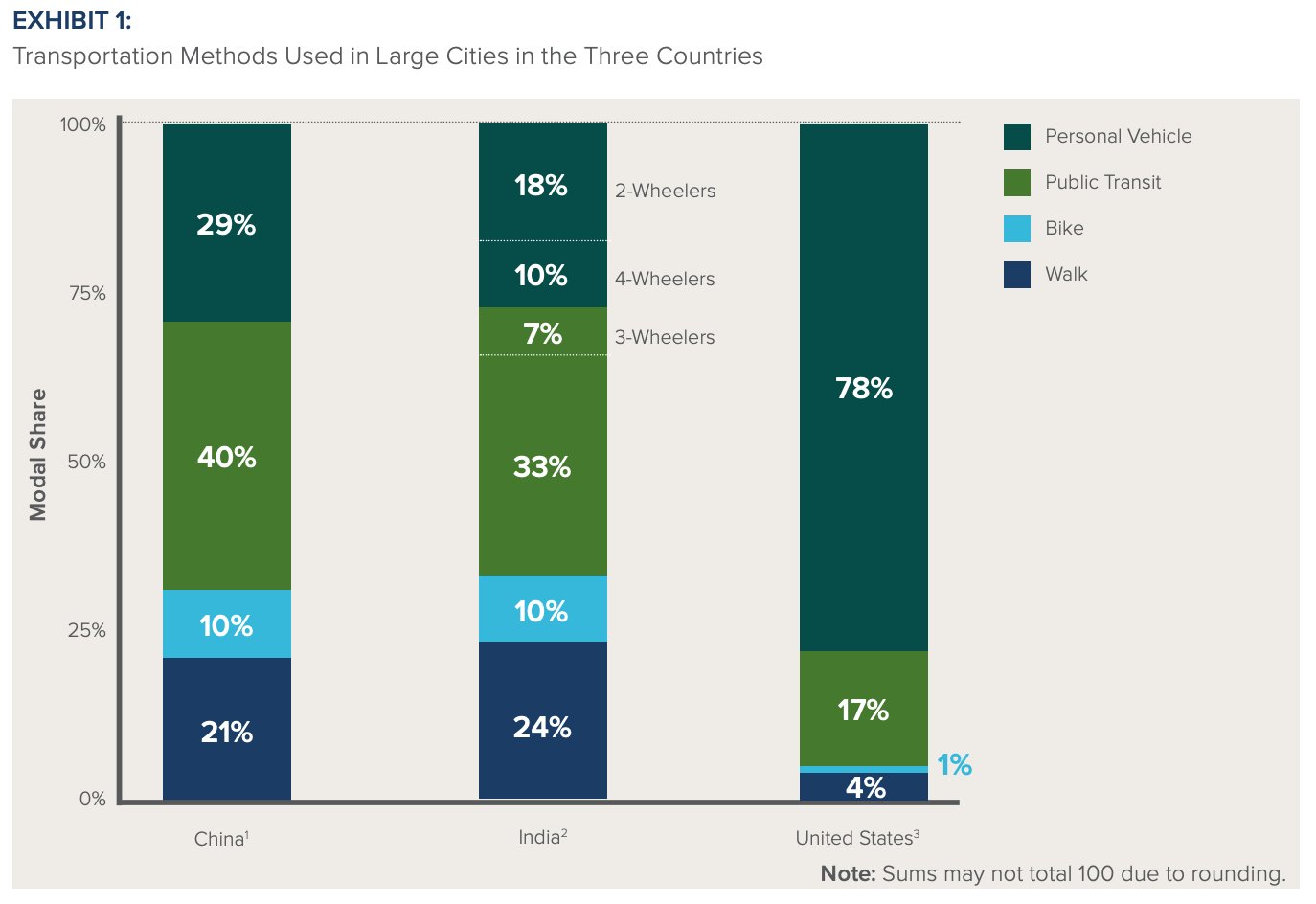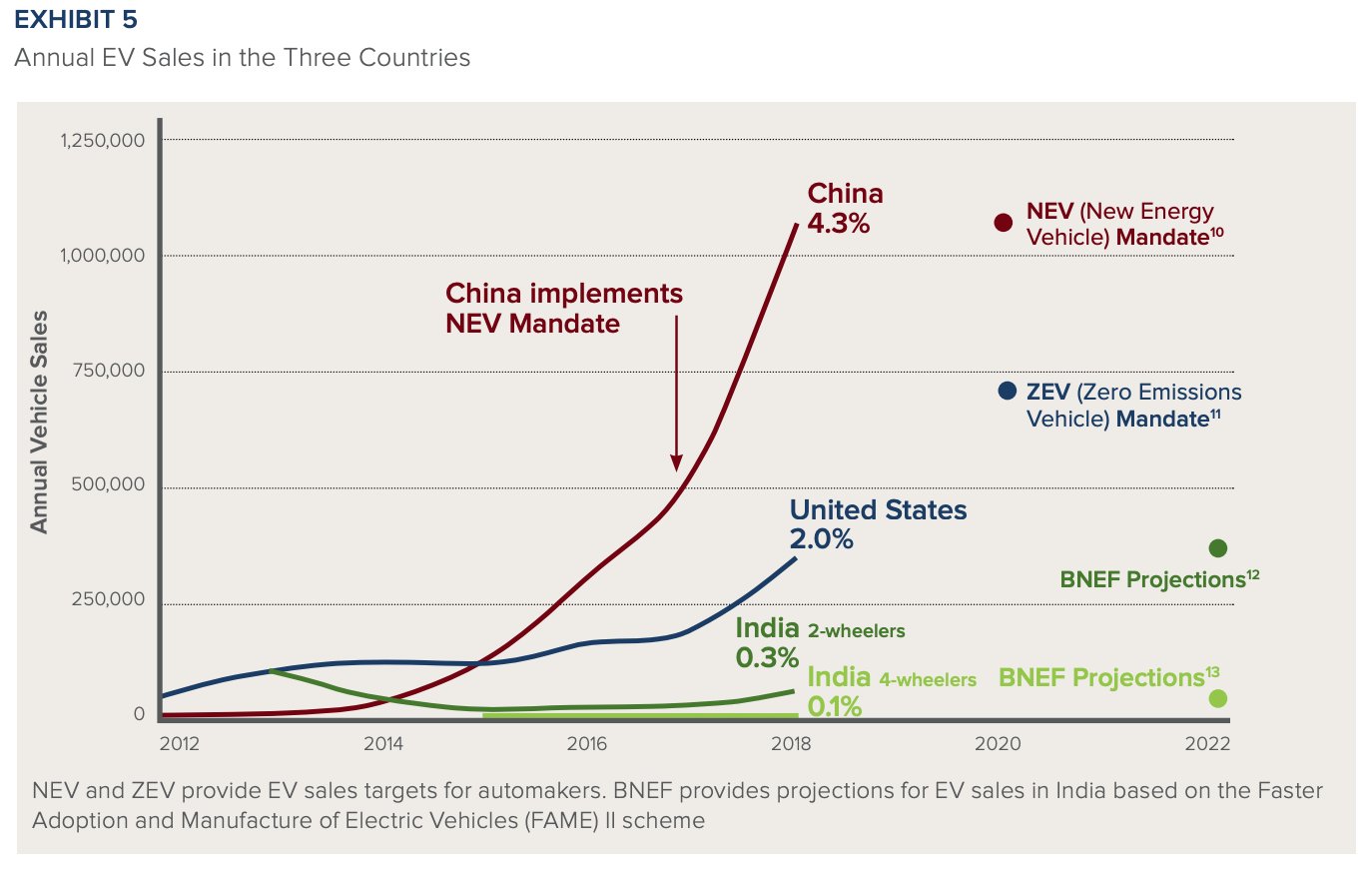The current mobility paradigm — characterized by privately owned, single-occupancy passenger vehicles — is expensive, polluting and inefficient. It’s also irresistibly convenient. And that presents a problem when it comes to addressing climate change, according to a recently released report from the Rocky Mountain Institute (RMI).
If left unchecked, continuing growth in passenger vehicle use around the world could undermine global climate change mitigation efforts. The Fifth Assessment Report of the United Nations Intergovernmental Panel on Climate Change determined that “[w]ithout aggressive and sustained mitigation policies being implemented, transport emissions could increase at a faster rate than emissions from the other energy end-use sectors.”
The combination of electric, autonomous and shared vehicles has the potential to significantly reduce carbon emissions in key markets by reducing both traffic congestion and tailpipe pollution. This combo could also boost safety and lower vehicle operating costs without sacrificing comfort and convenience.
The new RMI report looks specifically at the evolution of personal vehicle use in U.S., China and India, and how shared, electric and autonomous mobility services — collectively dubbed SEAMS — can serve as viable low-carbon transportation solutions in these markets. Below we examine the key takeaways.
Personal vehicle ownership is rapidly increasing in China and India
Personal vehicles have dominated transportation systems in U.S. cities for decades. Now, that trend is taking hold overseas.
Public transit and nonmotorized mobility methods have a larger modal share in Chinese and Indian cities. But in response to rapid economic development and globalization, consumers in these countries are starting to follow in the footsteps of Americans and demand personal vehicles to improve their mobility and convenience.
According to the RMI report, “personal vehicle ownership is rising rapidly in China and India, and could approach U.S. levels within a few decades.”

In absolute numbers, China already has the largest vehicle market in the world. But at only 17 percent car ownership per capita (compared to 76 percent in the U.S.), there is still enormous room for growth.
The uptake of personal vehicles in Chinese cities is already having a noticeable impact. In Beijing, for instance, bicycle rides accounted for 58 percent of commutes in 1986, but have cratered to less than 10 percent of commutes today.
India currently has around 9 percent car ownership per capita, with a stronger preference for scooters, motorcycles and auto-rickshaws. Two-wheeler vehicles are expected to continue their growth, driven by their affordability and maneuverability through congested roads. But the four-wheeler market is growing as well, due to improved job opportunities and increased disposable income.
So while the U.S. is at or nearing peak car ownership, China and India are rapidly moving in the opposite direction. The RMI report notes that these countries still have an opportunity to leapfrog the American paradigm of personal vehicle ownership and avoid the worsening patterns of congestion and pollution, while capturing billions of dollars in economic and social benefits.
However, “this opportunity will not be realized on its own and will require both policy and cultural change to facilitate the level of system transformation needed,” the report states.
SEAMS emerge as a viable alternative
If properly deployed, shared, electric and autonomous mobility services (SEAMS) have the potential to reduce congestion, boost safety and provide mobility at a lower cost per mile than operating a personal vehicle — without sacrificing comfort and convenience.
“The way we use personal combustion engine vehicles to move a single person is an inefficient way to move people around, not only from an energy perspective but also in terms of land space,” said Garrett Fitzgerald, a manager in RMI’s mobility transformation program and co-author of the report.
“To enable people in dense areas in India and China to move around efficiently almost requires that we move toward this shared and potentially autonomous future that has to be electric and renewable-energy-powered or we won’t get anywhere near our climate goals.”
One of the challenges is that SEAMS systems don’t exist yet. But the technology is rapidly advancing while the need continues to grow. There is also a risk that SEAMS will be deployed badly, which would undermine their potential greenhouse-gas-reducing benefits.
China, India and the U.S. are all moving toward a SEAMS future, according to RMI. “The key drivers for these technologies vary among the three countries as a result of their unique financial markets, government structures, and cultural attitudes,” the report states. However, there are many opportunities for shared learnings.

California, for instance, spearheaded the electric vehicle mandate, which several other states have now adopted. China adopted similar language to California’s EV mandate but implemented the program nationally, which resulted in far greater EV adoption — currently EVs account for 2 percent of annual sales in the U.S. versus 4.3 percent in China.
Incentivizing high-utilization electric vehicles
The first step in creating a SEAMS future is ensuring that the vehicles are electric. EVs currently account for less than 2.2 percent of global vehicle sales, despite the fact that recent years have seen recordbreaking sales in the top vehicle markets.
In the U.S., passenger EV sales totaled just over 360,000 in 2018, marking an 81 percent increase year-over-year, while Chinese passenger EV sales totaled roughly 1 million, jumping up 83 percent year-over-year. India also had a strong showing, with four-wheeler EV sales tripling in 2018; however, they continue to make up just a fraction of all vehicle sales.

India is taking a targeted policy approach to boosting its EV numbers, which the U.S. could learn from, according to RMI. Under India’s recently amended FAME II scheme, the government plans to subsidize 1 million electric two-wheelers, 500,000 electric three-wheelers, and 55,000 electric four-wheelers. The four-wheel EVs will only be subsidized for commercial and shared mobility use, however, not for private ownership.
This prioritizes vehicle segments that are both highly polluting and see high utilization. It also avoids the pitfall of subsidizing high-end vehicles for the wealthy. Meanwhile, the government has announced or implemented various demand-side fiscal and nonfiscal incentives, such as waived taxes and registration fees, to help increase adoption.
The U.S. stands to benefit from taking a page out of India’s book and refining its EV subsidy to prioritize high-utilization vehicles to maximize the number of vehicle miles electrified, the RMI report states.
Autonomous vehicle policy patchwork
When it comes to autonomous personal vehicles, the U.S. is leading the pack in terms of development and testing and private investment. China is actively trying to catch up by providing a clear policy pathway for bringing technology to market.
It’s a similar story with autonomous vehicle regulation as it is with EV policy, said Richard Li, mobility team associate at RMI and co-author of the report, where the U.S. has a patchwork of state policies that sends mixed signals to technology developers, while China has adopted a national framework.
“Certainly a country like China has a different appetite for that kind of top-down mandate, so that’s more feasible there than here,” he said. “But I think it goes to show the potential for what could be if the U.S. was able to pass a national autonomous vehicle framework through Congress.”
India, meanwhile, has expressly forbidden autonomous vehicle testing on public roads. Testing has been limited to closed tracks due to concerns that the technology could take away jobs and because policymakers and AV companies believe the nature of India’s roads may present a challenge for autonomous driving technology.
While the U.S. leads on autonomous vehicles, China is rapidly catching up. By making AV development a national priority, China aspires to be a global leader in AV production by 2025. The populace is also more welcoming toward the technology. A global survey conducted by Ipsos found that people in India and China are more than twice as willing to adopt AV technology, while almost a quarter of Americans refuse to ever use them.
 Safety is a big reason why American consumers are hesitant to embrace AVs. But there’s also a reasonable environmental concern.
Safety is a big reason why American consumers are hesitant to embrace AVs. But there’s also a reasonable environmental concern.
“There’s this heaven-or-hell scenario with autonomous vehicles,” said Li. There is a scenario in which gasoline-powered, privately owned AVs are asked to run mindless errands for their owners, clogging up streets and polluting the air, which is possible if AVs see significant cost declines in the next few decades.
“I think our biggest concern is ensuring future AVs are shared and electric. Electric probably will happen because of the economics and timeline for EV development, which is ahead of AV development,” said Li. “But ensuring they’re shared...will require policy intervention.”
There are already positive developments to point to here. Massachusetts, for instance, preemptively imposed higher taxes for single-occupancy autonomous vehicles than for shared ones. Policies such as this will be important to ensure that autonomous vehicle development aligns with global climate goals.
Shared mobility: A blessing or a threat?
Shared mobility services take on numerous forms, according to RMI, including ride-hailing, car-sharing, bike-sharing, scooter-sharing and van-pooling. Each of these options serves a different market segment and consequently has a different impact on emissions and traffic. Ride-hailing arguably stands to have the greatest impact, because it has the highest usage rates of all shared mobility services and could be the most likely to replace the role of private vehicles.

Ride-hailing adoption has already taken off in China, India and the U.S., with more than 700 million customers between them, which represents 80 percent of all ride-hailing users in the world. Ride-hailing usage is especially popular in China, where 37 percent of citizens are registered as ride-hailing users, which is more than double the rate of vehicle ownership.
The problem is that the majority of ride-hailing trips around the world are still single-occupancy, which doesn’t help much on the air quality and vehicle congestion front. In fact, these trips may be even worse for the climate.
That’s why the RMI report states, “it is essential that shared mobility services are pooled — to increase vehicle utilization and reduce congestion, and electrified — to avert worsening air pollution.” Congestion pricing and caps on ride-sharing drivers are two of the policy tools that can be adopted to promote sharing.
It’s also important for shared vehicle trips not to replace mass transit, which is the most efficient form of shared mobility in high-traffic areas. To do that, shared vehicles can integrate with the transit system to provide a first- and last-mile solution. China’s Didi ride-hailing service recently introduced a tool that allows users to book a full multimodal journey in its app, including mass transit and pooled rides to and from the train station.
“We don’t want to advocate that SEAMS should displace or disrupt public transit, but it might integrate or become a form of public transit,” said RMI's Fitzgerald.
Today, mass transit, walking and biking often aren’t done because people choose them, but because that’s the only option they can afford, he continued. SEAMS might be able to provide equal or greater service for a lower cost.
“If we intervene at the right time, China and India won’t choose a [personal gasoline-powered] vehicle because it’s more convenient; they will choose a SEAMS vehicle or mass transit because it’s more convenient.”